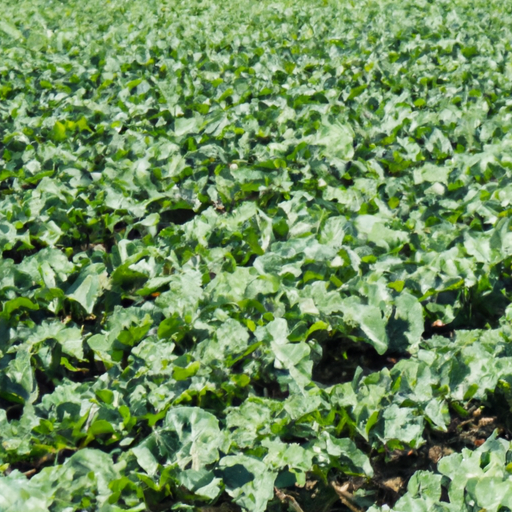Wandering through rows of vibrant green leaves, it is impossible not to be captivated by the wonders of a bountiful vegetable harvest. The sight of plump tomatoes, crisp lettuce, and vibrant bell peppers all sparkling under the early morning sun is a testament to the fruitful rewards of nature’s alchemy. While we marvel at the natural abundance, it is crucial to acknowledge the tremendous effort and expertise that lie behind the scenes. Farmers and horticulturists around the world have been tirelessly developing innovative techniques to maximize vegetable crops and foster a sustainable future. In this article, we will delve into the world of green harvest, uncovering the efficient techniques that harness the power of nature to deliver a cornucopia of vegetables for all to enjoy. Prepare to embark on an enlightening journey through the realm of agricultural marvels, as we unveil the secrets behind abundant vegetable crops and unveil a path towards a greener tomorrow.
– The Importance of Sustainable Agriculture Practices for Abundant Vegetable Crops
The Importance of Sustainable Agriculture Practices for Abundant Vegetable Crops
Growing abundant vegetable crops is not only crucial for meeting the increasing demand for fresh and nutritious food but also plays a vital role in promoting environmental sustainability. Implementing sustainable agriculture practices can help ensure the long-term viability of vegetable farming while minimizing negative impacts on the ecosystem. By adopting these practices, farmers can preserve soil fertility, conserve water resources, and protect biodiversity, thus securing a healthy and prosperous future for both people and the planet.
One key aspect of sustainable agriculture is the use of organic fertilizers instead of chemical ones. These natural alternatives promote the growth of healthy and resilient vegetable crops while minimizing soil degradation and water pollution. Furthermore, incorporating cover crops into farming systems helps prevent erosion, enhances soil structure, and reduces the need for synthetic pesticides. By employing crop rotation techniques, farmers can effectively manage pests and diseases, maintain balanced nutrient levels, and enable the soil to naturally replenish its fertility. This approach not only promotes ecosystem health but also contributes to the overall quality and taste of the vegetables produced.
– Unlocking the Secrets to Increased Crop Yields: Promising Techniques That Promote Sustainable Farming
Unlocking the Secrets to Increased Crop Yields: Promising Techniques That Promote Sustainable Farming
When it comes to sustainable farming, there are a plethora of innovative techniques that hold the key to unlocking higher crop yields while safeguarding our environment. Modern farmers are embracing these techniques and witnessing unprecedented results, revolutionizing the agricultural industry. Here, we reveal some promising methods that can significantly boost crop productivity:
- Precision Agriculture: By leveraging cutting-edge technologies such as drones, GPS, and sensors, farmers can precisely monitor and manage their crops. This enables them to optimize fertilizer and pesticide applications, leading to better yield and reduced environmental impacts.
- Vertical Farming: As space becomes scarcer, urban farmers are turning to vertical farming to cultivate crops in stacked layers. Using hydroponics or aeroponics, this technique requires fewer resources, such as water and land, while allowing constant crop production throughout the year.
- Agroforestry: By strategically integrating trees with crops, agroforestry systems offer multi-faceted benefits. The tree canopy provides shade, reducing water evaporation, and promoting soil moisture retention. Simultaneously, it adds organic matter, enhances biodiversity, and sequesters carbon, contributing to climate change mitigation.
These are just a glimpse of the many exciting advancements in sustainable farming that hold tremendous potential for boosting crop yields while minimizing environmental impact. As we continue to explore these techniques and adapt them to various farming contexts, we move closer to an agricultural system that embraces sustainability and secures our future food security.
– Optimal Soil Management and Nutrient Balance: Essential Strategies for Green Harvest
Optimal Soil Management and Nutrient Balance: Essential Strategies for Green Harvest
Creating a thriving garden begins with understanding the importance of optimal soil management and maintaining a nutrient balance. By implementing these essential strategies, you can ensure a green and bountiful harvest.
First and foremost, soil management is the key to a successful garden. Implementing the following techniques will help you achieve healthy soil:
- Organic Matter: Adding compost or well-rotted manure will enhance the soil’s structure and increase its water and nutrient-holding capacity.
- Mulching: Applying organic mulch, such as straw or wood chips, will protect the soil from erosion and temperature fluctuations, as well as supply nutrients as it breaks down.
- Minimal Tilling: Avoid excessive tilling as it can disrupt the soil’s natural composition and beneficial organisms. Instead, adopt techniques like no-till gardening or strategic tilling only when necessary.
Equally important, maintaining a proper nutrient balance is essential for plant growth and overall health. Consider the following tips:
- Soil Testing: Regularly test your soil to determine its nutrient levels. This will help you understand what specific amendments are required for optimal growth.
- Rotation: Practice crop rotation to prevent nutrient depletion in the soil. By rotating different plant families each season, you can reduce the risk of pest and disease buildup while promoting nutrient balance.
- Fertilizer Application: When supplementing nutrients, opt for slow-release organic fertilizers that provide a gradual and sustained nutrient release, avoiding potential harm caused by over-fertilization.
By prioritizing optimal soil management and maintaining a nutrient balance, your garden will flourish, resulting in a vibrant and abundant harvest. Remember, a well-cared-for soil is the foundation for healthy plants and the key to sustainable gardening.
Closing Remarks
As we conclude this mesmerizing journey through the realm of sustainable agriculture, one thing becomes abundantly clear: the possibilities for bountiful vegetable crops are as limitless as the lush fields themselves. Never before have we ventured so deep into the world of green harvest, uncovering an array of efficient techniques that promise abundant yields while preserving our precious environment.
From the moment we stepped foot into the enchanting domain of organic farming, we were captivated by its harmony with nature. We explored the innovative techniques that skilled farmers employ to enhance soil health, from cover cropping and crop rotation to the meticulous attention given to nutrient management. Delving further, we marveled at the ingenuity behind hydroponics and aquaponics, where plants thrive without soil and water becomes an integral part of their growth. It’s a symphony of ecological balance and efficiency, where every drop of water and every nutrient count.
In our quest for sustainable excellence, we immersed ourselves in the world of permaculture. With every intricate design and harmonious collaboration between animals and plants, we discovered a tapestry woven by Mother Nature herself. Here, creativity and resourcefulness blend seamlessly to unlock the full potential of vegetable crops, turning gardens into vibrant ecosystems teeming with life.
While our journey might have captivated us with mesmerizing techniques, it is the overarching ethos that truly touched our souls. We experienced firsthand the power of regenerative agriculture, where every planting decision is a statement for a better future. A future where soil degradation is reversed, where biodiversity thrives, and where resilient ecosystems stand tall against the challenges of our changing world.
As we bid farewell to this exploration, one thing is certain: the potential for abundant vegetable crops lies not only in the seeds we sow but in the wisdom we gather along the way. The knowledge we have uncovered in this odyssey will serve as a guiding light for farmers, researchers, and dreamers alike, as they venture forth towards a greener, more sustainable future.
So let us embark on this journey together, hand in hand, as we harness the power of efficient techniques and bring forth a harvest that nourishes not only our bodies but also the very fabric of our planet. It is time to embrace the green revolution, where abundance and sustainability unite into a harmonious dance that nature herself applauds. The future is ripe for the picking, and our call to action begins now.
The world population is growing, and not only are we running out of space to provide food to everyone, but also the environment needs to be taken into consideration. For this reason, a new concept has been introduced: green harvest. Green Harvest is about using efficient farming techniques to produce abundant vegetable crops for everyone.
With green harvest, farmers are encouraged to make use of modern farming methods such as planting cover crops, which can help reduce erosion and retain soil fertility. This method is also known as crop rotation and is used to improve soil quality. Additionally, green harvest encourages farmers to make use of sustainable organic fertilizers which help increase the yield, as well as follow modern irrigation techniques to prevent water wastage. In addition to this, farmers who are part of the green harvest initiative are taught different non-chemical pest control methods, such as encouraging beneficial insects to combat crop-killing pests.
Green harvest also encourages farmers to practice intercropping, which is a technique used to grow two or more crops in the same land. Intercropping enables faster land clearing, reduced weeding, and improved soil fertility. Additionally, farmers are being taught how to conserve energy through using solar powered pumps for irrigation and provided with the option of using renewable energy sources for other farming activities.
This program does not only benefit farmers, but also the environment and consumers. The environment benefits due to the reduced use of pollutants. Consumers benefit from the abundance of vegetables at reasonable prices and with high nutritional value.
All in all, green harvest is offering a solution to the global food insecurity by introducing efficient farming techniques to grow abundant vegetable crop. This helps to reduce environmental damage while providing sustainable food sources for everyone.



